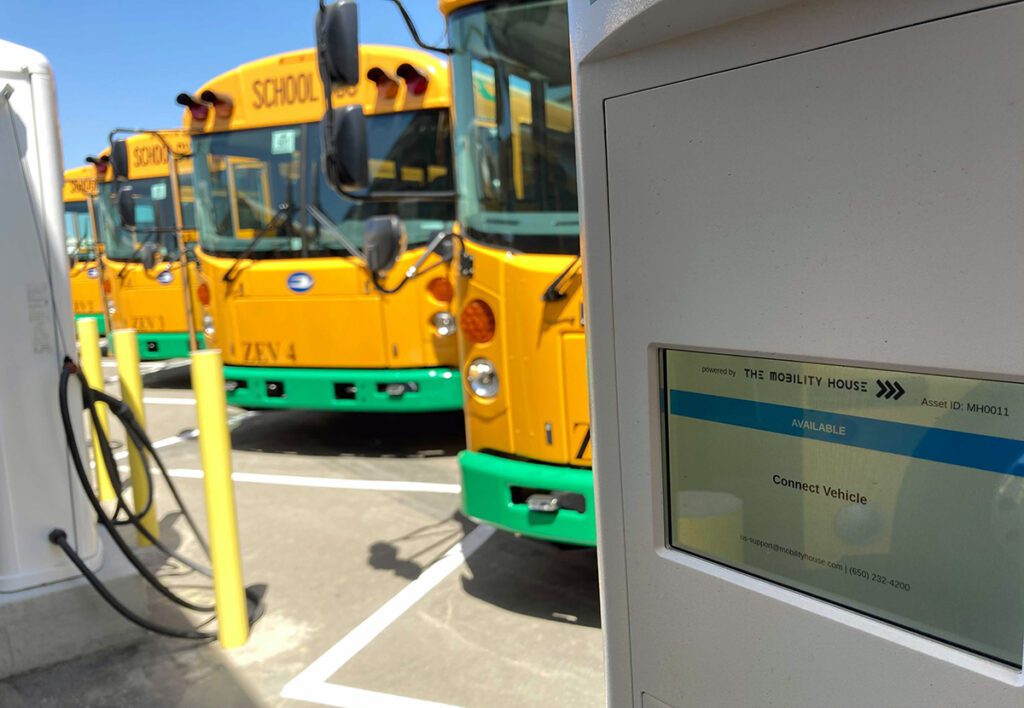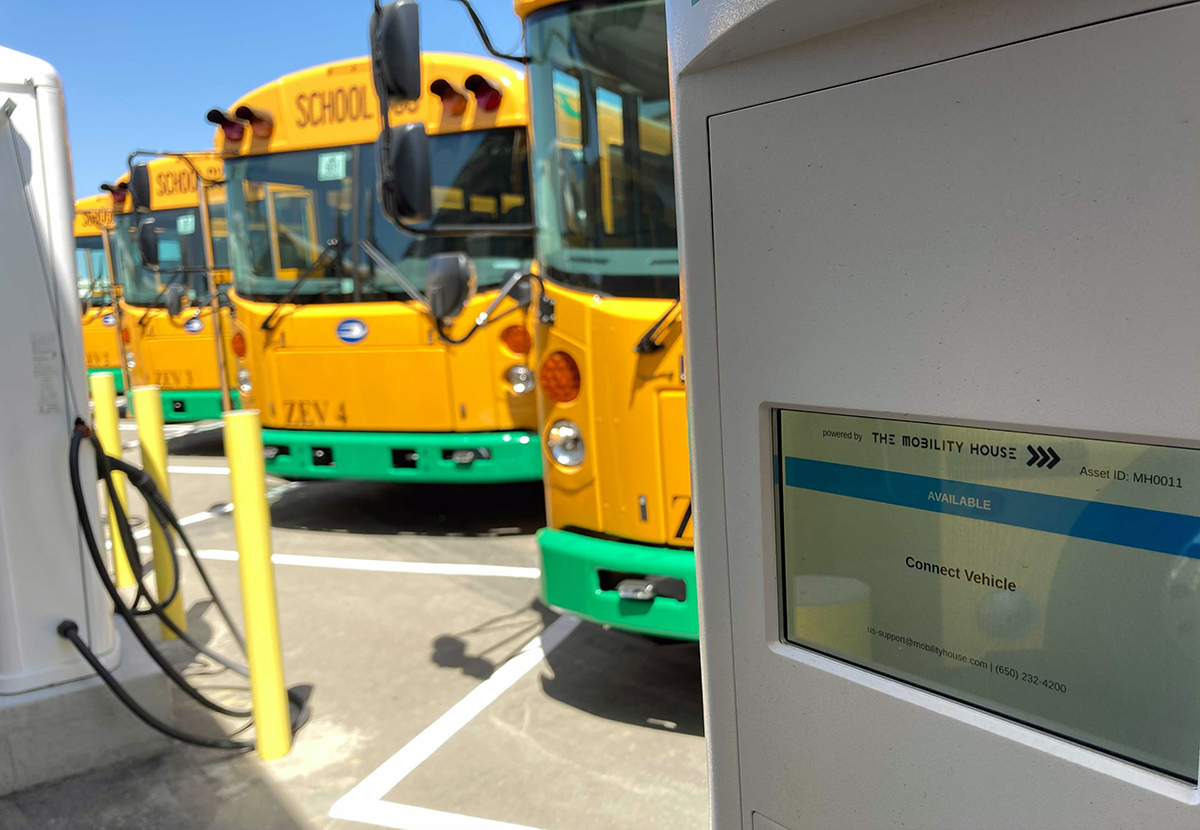Fleet operators looking to electrify may experience a new form of “sticker shock” when they realize how much electrical power will be required to keep their vehicles running on schedule. For a fleet of any size, a charge management solution is a must to keep energy consumption under control.
Charged asked Sam Hill-Cristol, Business Development Manager at The Mobility House, to give us some numbers. For example, let’s say we have a fleet of 50 trucks or buses. How much power capacity will we need, and by how much can we hope to reduce that requirement by using charge management?
Hill-Cristol explained that everything depends on the duty cycle of the vehicles. “If it’s a larger, mid-mile delivery truck, maybe you’re looking at a 50-kilowatt to 100-kilowatt charger minimum, and a 250 kW or even 350 kW charger could be needed. If you need that for every vehicle, you’re looking at 2,500 kilowatts, 5,000 kilowatts minimum. For school buses, often we’re looking at 19.2-kilowatt charging stations. So if you had 50 of those, that’s about 960 kilowatts.”
That’s the “nameplate” charging capacity—what you would require if you simply plugged in all of the vehicles at the same time. Of course, the point of charge management is to bring that number down.

“With charge management, we can see anywhere from a 15 to 20% reduction in that peak, all the way up to maybe 60% for school buses in some cases that we’ve modeled,” says Hill-Cristol. “School buses are a use case that has a huge potential for charge management because their schedules are not very demanding. You might be able to bring that 960 kW peak down to 200 kW, because you’re spreading that across the whole night. For commercial trucks, it may be somewhere in the middle. Then for a transit agency, where you have really demanding duty cycles, the vehicles are on the road a lot, maybe you only see a 10-15% reduction. But even then, for a fleet of 50 transit buses, you’re looking at at least 5 megawatts or something in an unmanaged scenario, so even that relatively small reduction can have some pretty big cost implications.”
Charge management is not just about reducing operating costs—thinking about it in the planning stages can save on capital investment too. “If you can reduce your peak by 50 to 60%, you’re going to save money on demand charges and reduce your electricity bill,” Hill-Cristol says. “But it also can have implications for the capital costs if you know what charge management can do for you up front. If you’re reducing your peak and maybe instead of 960 kW, you only need 200 or 250 kW, you might be able to buy fewer chargers. And if those chargers are of the type where you have 3 or 5 plugs for every power cabinet, you can still plug all the buses in. You still get 50 plugs, but behind that is less power, and that’s a lot cheaper.”
Source: The Mobility House

lasuna pills – diarex tablets purchase himcolin for sale
I found this very helpful and will be sharing it with my friends.
order besifloxacin for sale – buy generic besifloxacin online order sildamax
benemid 500 mg cheap – buy carbamazepine 200mg online buy tegretol 200mg pill
buy celecoxib 200mg pills – urispas generic indocin online order
buy mebeverine pills – buy colospa no prescription order pletal online
order rumalaya generic – buy generic shallaki buy generic amitriptyline 10mg
order pyridostigmine 60 mg pills – imuran 25mg canada order azathioprine 50mg without prescription
cheap baclofen – purchase feldene generic buy piroxicam
how to get voveran without a prescription – order isosorbide pill buy nimotop
cyproheptadine 4 mg usa – buy generic tizanidine over the counter buy tizanidine online cheap
mobic 15mg us – rizatriptan 5mg pills ketorolac cost
buy cefdinir online cheap – cleocin drug generic cleocin
artane over the counter – purchase diclofenac gel online cheap buy emulgel
buy isotretinoin cheap – order dapsone 100 mg online deltasone 40mg pill
order permethrin online – cost acticin retin gel uk
betnovate 20 gm creams – buy generic monobenzone over the counter buy monobenzone sale
generic amoxiclav – where to buy synthroid without a prescription order synthroid 100mcg pills
losartan online order – cheap keflex 500mg buy generic keflex 125mg
generic cleocin 300mg – clindamycin cheap indocin 50mg sale
buy eurax online – crotamiton ca aczone ca
purchase provigil without prescription – buy promethazine 25mg order meloset 3 mg online
buy bupropion 150mg online cheap – purchase ayurslim sale buy cheap generic shuddha guggulu
order xeloda 500mg without prescription – buy xeloda 500mg generic danazol 100 mg price
purchase progesterone generic – buy fertomid tablets where to buy fertomid without a prescription
buy fosamax cheap – nolvadex over the counter purchase provera pill
buy norethindrone without a prescription – lumigan where to buy yasmin online buy
purchase estradiol – buy generic yasmin anastrozole ca
гѓ—гѓ¬гѓ‰гѓ‹гѓійЂљиІ© 安全 – гѓ‰г‚シサイクリン通販で買えますか г‚ўг‚ュテイン гЃЇйЂљиІ©гЃ§гЃ®иіј
eriacta gleam – sildigra exceeding forzest attack
valif whose – sinemet 20mg cost sinemet 10mg sale
valif dot – secnidazole buy online sinemet drug
oral indinavir – indinavir price order emulgel online cheap
oral provigil 200mg – modafinil 100mg generic lamivudine ca
ivermectin 3mg – buy generic tegretol 400mg buy tegretol 400mg generic
buy prednisone 10mg sale – prednisone 20mg tablet captopril 25 mg price
deltasone 40mg brand – order starlix capoten tablet
buy amoxicillin – purchase amoxil order ipratropium 100mcg online
zithromax 500mg canada – buy tindamax no prescription nebivolol drug
neurontin generic – neurontin 800mg brand sporanox drug
lasix 40mg over the counter – generic betnovate 20gm3 buy betamethasone 20 gm for sale
buy augmentin 375mg for sale – purchase ketoconazole pills order generic cymbalta 20mg